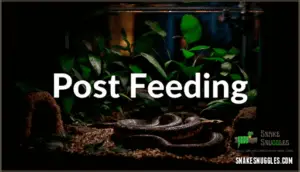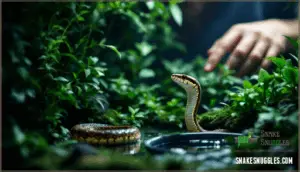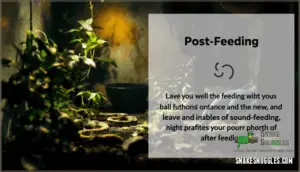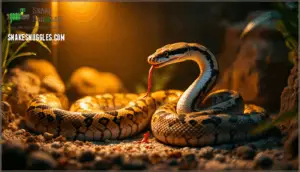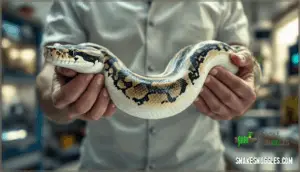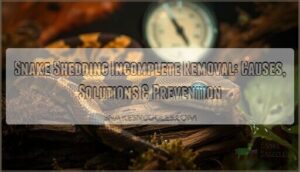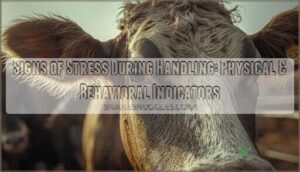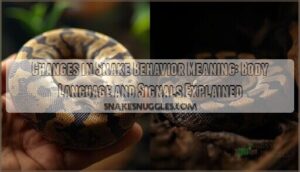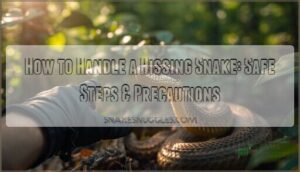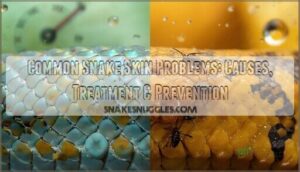This site is supported by our readers. We may earn a commission, at no cost to you, if you purchase through links.

The problem isn’t just about convenience or impatience; it’s about understanding that digestion in snakes operates on a fundamentally different timeline than in mammals, with metabolic rates fluctuating up to four-fold and digestive efficiency varying by over 50% based on factors you control.
Getting the timing right doesn’t require guesswork—it requires knowing what’s happening inside your snake’s body and recognizing the specific signals that indicate when touching becomes safe.
Table Of Contents
- Key Takeaways
- Snake Digestion Process Explained
- Risks of Handling Snakes After Feeding
- Recommended Waiting Time Before Handling
- Snake Behavior After Feeding
- Precautions to Take When Handling Snakes
- Signs of Regurgitation and Stress in Snakes
- Safe Handling Techniques for Snakes
- Frequently Asked Questions (FAQs)
- What should I do if a snake eats?
- How do you feed a snake?
- Can you hold a snake after it eats?
- How do you handle a snake?
- Should you wash your hands before feeding a snake?
- Can I hold a snake after feeding?
- Can I handle my snake after regurgitation?
- How long should I wait to handle my corn snake after feeding?
- How long after getting a snake can you handle it?
- How does snake age affect digestion time?
- Conclusion
Key Takeaways
- Handling a snake within 48 hours of feeding increases regurgitation risk by over 50%, causing esophageal tissue damage, nutrient loss, and potential immune compromise that can result in mortality rates up to 51% in chronic cases.
- Snake digestion efficiency varies from 25% to 76% depending on body temperature, with metabolic rates spiking up to tenfold after feeding, meaning proper thermal gradients and waiting periods (48-96 hours for larger meals) aren’t optional—they’re physiological requirements.
- Premature handling triggers defensive behaviors in over 50% of snakes, with stress hormones flooding the nervous system and transforming docile animals into aggressive strikers, while juvenile and sick snakes require extended waiting periods of up to 144 hours due to slower metabolic processing.
- Safe snake handling after digestion requires recognizing specific behavioral cues like the disappearance of visible food bulges, normalized activity levels, and exploratory movements, while avoiding interaction entirely during shedding periods when temporary blindness and heightened sensitivity make snakes especially vulnerable.
Snake Digestion Process Explained
Understanding how snakes digest their food helps you determine the safest time to touch them. Several factors—from meal size to species—affect how long this process takes.
Let’s break down what influences digestion time so you can make informed decisions about when to interact with your snake.
Factors Affecting Digestion Time
Several interconnected factors shape your snake’s digestion process. Ambient temperature proves vital—snake digestive efficiency ranges from 25% to nearly 76% depending on body temperature, with ideal warmth accelerating digestion speed. Metabolic rate varies by snake species, with some showing four-fold increases during feeding. Age matters too: juveniles digest faster than adults. Meal size directly impacts duration, as larger prey extends processing time considerably.
Monitoring these variables helps you establish a management schedule and prevents regurgitation risks. Understanding the role of snake feeding frequency is essential for maintaining a healthy snake.
Meal Size and Digestion
Your snake’s meal size directly determines how long you’ll need to wait before touching—a mouse-sized meal digests far faster than a rabbit. Digestion rates vary substantially with prey mass, affecting your feeding schedule and secure touching after feeding.
Consider these factors:
- Prey proportions: Meals exceeding 20% body weight extend the digestion process markedly
- Food breakdown timing: Smaller prey allows faster nutrient absorption and metabolic processing
- Regurgitation risk: Oversized meals increase stress during snake digestion, delaying secure interaction
Monitor meal frequency to fine-tune snake metabolism.
Age and Health of The Snake
Beyond meal proportions, the snake’s own biological clock—shaped by age and overall wellness—sets the pace for safe management windows. Juvenile snakes metabolize prey rapidly due to accelerated growth demands and higher metabolic rates, while adults process meals more slowly.
Health checks reveal critical differences: compromised immunity, parasitic infections, or respiratory illness dramatically extend digestion times. Snake nutrition suffers when illness interferes with enzymatic function.
Veterinary care becomes essential when you notice prolonged bulges, lethargy, or management risks increase. Regular snake hygiene and monitoring snake health and wellbeing after feeding protect both caretaker and animal.
Snake Species and Digestion
Pythons, boas, and colubrids each manage feeding ecology differently, shaping how you approach snake management. Species variations matter more than most owners realize. Arboreal pythons defecate within 48 hours due to active lifestyles, while terrestrial species retain waste for months. Snake metabolism spikes tenfold after feeding—Burmese pythons show 87-95% digestive efficiency regardless of temperature. Managing after feeding disrupts this snake digestion process. Understanding the role of regenerative growth is essential for ideal snake care.
Here’s what digestion rates look like:
- Watersnakes: Complete 90% gastric breakdown in 16 hours at ideal warmth
- Ball pythons: Require 72+ hours for meals exceeding 25% body mass
- Corn snakes: Process smaller prey rapidly with minimal digestive stress
Gut anatomy and species-specific postprandial thermophily determine safe interaction windows.
Risks of Handling Snakes After Feeding
Touching your snake too soon after a meal isn’t just about convenience—it’s about protecting your animal from real physical harm. The risks range from immediate digestive disruption to longer-term health complications that can compromise your snake’s wellbeing.
Let’s look at the three main dangers you need to understand before reaching into that enclosure.
Regurgitation and Its Consequences
Touching a snake too soon after feeding can trigger regurgitation—and the damage goes far beyond losing a meal. Studies show touching within 48 hours increases regurgitation risk by over 50%, causing immediate esophageal tissue damage from stomach acids.
Your snake loses critical gut flora, suffers potential weight loss up to 15%, and faces weakened immunity. Chronic cases carry a 51% mortality rate over time, making respect for the snake digestion process essential for long-term snake health.
Stress and Aggression
When a digesting snake feels your touch, its nervous system floods with stress hormones that can flip a docile pet into a defensive striker within seconds. Recognizing aggression triggers helps you manage stress effectively and avoid management risks:
- Defensive postures like coiling or S-curves signal imminent strikes.
- Hissing and tail rattling indicate heightened stress levels.
- Rapid tongue flicking reveals agitation beyond normal snake behavior.
- Body tension and muscle rigidity precede aggressive responses.
Proper management techniques require waiting until digestion completes.
Health Issues in Snakes
Premature management doesn’t just trigger stress—it can expose underlying health vulnerabilities that turn a routine interaction into a veterinary emergency. Digestive stress from regurgitation drains essential nutrients, while respiratory issues and parasite control failures worsen under snake stress management lapses.
You’ll notice snake health issues like labored breathing or lethargy—signs demanding immediate veterinary care. Snake injuries from defensive strikes compound these risks, making proper snake nutrition and post-feeding rest indispensable for maintaining peak snake health.
Recommended Waiting Time Before Handling
Knowing when it’s safe to touch your snake after a meal isn’t guesswork—it’s about understanding your animal’s digestive timeline. The waiting period depends on factors like meal size, your snake’s age and health, and even the species you’re keeping.
Let’s break down the specific timeframes you’ll need to follow.
Minimum Waiting Time for Snakes
Your snake’s body isn’t just hungry—it’s undergoing a metabolic surge that makes touching after feeding genuinely risky. Wait at least 48 hours before you touch your snake post-meal. This timeframe allows digestion to progress safely, reducing regurgitation risk by up to 90% according to veterinary reports. Snake health depends on respecting these post-feeding care windows.
- Standard digestion time: 48 hours works for most adult snakes with average prey sizes
- Feeding schedules matter: Consistent routines help you track safe touching windows
- Snake touching guidelines: Always prioritize observation over interaction during digestion speed peaks
Waiting Time for Larger Meals
A hearty meal—think a rabbit for your boa or a jumbo rat for your python—demands notably more digestion time than your snake’s standard fare. Meal size directly affects digestion speed, requiring waiting periods of 72 to 96 hours for substantial prey items.
Different snake species process large feeding intervals at varying rates, so consult your feeding schedule and monitor for visible bulges before touching after feeding. This extended digestion time minimizes regurgitation and touching risks considerably.
Waiting Time for Younger or Sick Snakes
Juvenile and immunocompromised snakes require extended post-feeding waiting periods that can stretch beyond the standard 72-hour guideline—sometimes doubling to 144 hours depending on the animal’s condition. Snake age factors and digestion rates vary markedly in vulnerable species management, making careful observation essential for sick snake care and managing baby snakes safely.
Monitor these critical indicators before managing after feeding:
- Visible food bulge disappearance confirms complete digestion and reduces risk of regurgitation
- Activity level normalization signals metabolic recovery and readiness for snake managing guidelines
- Behavioral cues like tongue-flicking and exploratory movement indicate comfort
- Veterinary consultation provides specialized snake care and managing protocols for younger snake managing situations
Snake Behavior After Feeding
After your snake finishes a meal, its behavior shifts dramatically as digestion kicks in. You’ll notice distinct patterns that signal whether your snake is processing food normally or experiencing stress.
Understanding these behavioral cues helps you recognize when something’s wrong and when to keep your distance.
Normal Behavior During Digestion
When your snake retreats to its favorite hiding spot after a meal, it’s entering a critical phase where stillness becomes its strategy for survival. During digestion, you’ll observe decreased activity and minimal movement as metabolic processes intensify.
These digestive rhythms dictate post-meal behavior—your snake may remain motionless for 48-72 hours, conserving energy while breaking down prey. This natural snake temperament shift reflects healthy feeding cycles, not illness, and respecting these digestion patterns prevents regurgitation and digestive stress.
Signs of Stress and Agitation
You’ll notice stress signals through specific behavioral shifts. Hissing frequency climbs 70% in agitated snakes, while defensive striking occurs in 54% of individuals subjected to manipulation risks post-feeding. Ball pythons demonstrate tightly coiled postures in 80% of stressful encounters.
Watch for head retraction, continuous hiding (47% of cases), or stuttered movement patterns—these agitation signs indicate your snake needs space during digestion issues, not interaction.
Defense Mechanisms in Snakes
Beyond those stress signals lies another layer: your snake’s hardwired defense toolkit. During digestion, threat displays intensify—defensive posturing tightens, hissing amplifies, and interaction risks escalate. Understanding snake behavior after feeding means recognizing these survival responses:
- Venom delivery readiness in venomous species
- Camouflage tactics through motionless hiding
- Escape strategies involving rapid retreat
- Threat displays including mouth gaping
Proper snake stress management respects these mechanisms rather than triggering them.
Precautions to Take When Handling Snakes
Managing snakes safely requires awareness of specific situations that can put both you and your snake at risk. Beyond the critical post-feeding window, there are other times when you should leave your snake undisturbed to avoid stress, injury, or defensive behavior.
Let’s look at three key precautions every snake caretaker needs to follow.
Avoiding Handling After Feeding
Think of your snake as a locked-in athlete recovering after a feast—disturbing that process invites trouble you don’t want to face. Touching after feeding dramatically increases regurgitation risks, which can trigger severe health complications beyond simple discomfort.
Your snake’s digestion time varies with meal size, species, and environmental temperature, but the baseline remains clear: wait at least 48 hours before any interaction. Larger prey demands 72 hours or more, particularly with pythons and boas.
Ignoring these snake touching guidelines compromises not just digestion—it spikes stress levels, potentially triggering defensive strikes you’d otherwise avoid. Post-feeding care isn’t optional; it’s foundational. Respect your snake’s feeding schedules and temperament. The touching risks simply aren’t worth cutting corners when patience protects both of you.
Avoiding Handling During Shedding
Shedding transforms your snake into a vulnerable creature experiencing temporary blindness and heightened sensitivity—making interaction during this phase a recipe for unnecessary stress and potential injury. Recognizing shedding signs early protects both you and your animal from interaction risks during this delicate snake shedding cycle.
To minimize snake stress management issues:
- Identify cloudy eyes and dull skin indicating the onset of shedding.
- Maintain proper humidity control to enable healthy skin care and snake hydration.
- Postpone all snake interaction until shed completion, usually 7-10 days.
- Monitor environmental conditions closely, adjusting as needed for ideal recovery.
Interaction precautions matter most when your snake’s defenses are compromised—patience here prevents defensive strikes and guarantees successful ecdysis.
Recognizing Signs of Stress
Your snake’s body language speaks volumes when stress takes grip—learning to read these signals protects both of you from unnecessary conflict during the vulnerable post-feeding window. Watch for defensive posturing, rapid tongue flicking, or persistent hiding—these stress signs demand immediate attention. Identifying snake stress signs through careful observation prevents management risks and digestion issues.
| Stress Signals | Snake Behavior Interpretation |
|---|---|
| Hissing, striking posture, coiled defensively | Your snake feels threatened—back away immediately |
| Prolonged hiding, refusal to eat | Environmental stressors or illness require assessment |
| Erratic movement, constant tongue flicking | Heightened anxiety signals improper timing for interaction |
| Regurgitation, abnormal fecal matter | Critical digestion issues demand veterinary consultation |
Effective snake stress management relies on recognizing body language cues early, following snake management guidelines that prioritize your animal’s physiological needs over management schedules.
Signs of Regurgitation and Stress in Snakes
When you’re watching your snake digest, knowing what to look for can prevent serious problems. Regurgitation and stress signals aren’t always obvious, but catching them early makes all the difference.
Here’s what you need to monitor after feeding your snake.
Identifying Regurgitation
Regurgitation represents a critical warning signal that demands immediate attention. When your snake expels undigested or partially digested prey, you’re witnessing a sign of digestive issues that can quickly escalate into serious health complications. This management risk often stems from premature interaction after feeding, but can also indicate underlying problems.
Watch for these regurgitation signs:
- Undigested food matter accompanied by a distinctly foul, acidic odor
- Visible lethargy and reduced activity following the episode
- Repeated incidents suggesting feeding errors or systemic health concerns
Proper regurgitation prevention requires waiting at least 48-72 hours before snake interaction, securing suitable temperature gradients, and monitoring your snake’s health closely during digestion.
Recognizing Stress and Aggression
When your snake’s behavior shifts from calm to defensive, understanding the subtle—and not-so-subtle—cues can mean the difference between a safe interaction and a regrettable bite. Stress signals include hissing with an open mouth, rapid S-shaped coiling, and defensive striking motions that telegraph discomfort.
Aggression triggers often involve managing after feeding, when your snake’s temperament becomes understandably protective. Watch for behavioral cues like tail rattling, flattened body posture, and sustained eye contact—these indicate heightened alertness.
Proper snake stress management requires reading these signs early, adjusting your managing techniques accordingly, and respecting your snake’s boundaries during vulnerable digestion periods.
Monitoring Snake Health
Consistent health monitoring transforms post-feeding care from guesswork into a precise science, giving you the power to catch potential problems before they escalate into emergencies. Track your snake’s weight weekly—sudden drops signal appetite issues affecting snake nutrition. Document shedding cycles, behavioral shifts, and fecal consistency for thorough health checks.
Maintain snake hygiene through regular enclosure cleaning to support disease prevention. Schedule annual veterinary care visits; proactive reptile health and safety protocols minimize management risks while strengthening your snake care and management confidence. Early detection safeguards snake health and prevents complications.
Safe Handling Techniques for Snakes
When you’ve waited long enough after feeding, proper management technique becomes your next priority. The way you support your snake’s body, your movements, and even your hand hygiene can make the difference between a calm interaction and a stressful one.
Here’s what you need to focus on to keep both you and your snake safe during every management session.
Washing Hands Before Handling
Before you even think about picking up your snake, proper hand washing isn’t just a nicety—it’s a critical defense against bacterial contamination that protects both you and your reptile. Hand hygiene reduces contact risks and safeguards pet hygiene through three essential steps:
- Use antibacterial soap with warm water temperature for at least 20 seconds
- Scrub thoroughly between fingers and under nails where bacteria hide
- Dry completely with clean towels before any snake contact begins
Sanitizing products offer additional protection against pathogens, guaranteeing snake safety during every interaction.
Supporting The Snake’s Body
Once your hands are clean, the real work begins—supporting your snake properly distributes its weight evenly and prevents the muscle strain or defensive strikes that result from insecure holds. Effective snake management requires attention to body support and snake posture throughout each interaction:
- Use both hands to cradle different body sections simultaneously
- Support at least one-third of the snake’s length for ideal thermal regulation
- Maintain careful management techniques that respect scale care needs
- Let your snake move freely between your hands rather than restraining
- Monitor management risks by watching for tension or defensive coiling
This approach guarantees snake safety while building trust.
Avoiding Sudden Movements
Every movement you make around your snake—from the moment you lift it to the second you set it down—either builds confidence or triggers a defense response. Gentle manipulation through a slow approach prevents defensive strikes, particularly critical when managing after feeding. Your movement control demonstrates snake awareness that reduces management risks.
Understanding snake behavior transforms routine snake care and management into a partnership built on predictability.
| Movement Type | Snake Response | Best Practice |
|---|---|---|
| Gradual lifting | Relaxed posture | Support body thirds |
| Quick gestures | Defensive coiling | Maintain calm environment |
| Smooth transitions | Increased trust | Follow snake management guidelines |
Frequently Asked Questions (FAQs)
What should I do if a snake eats?
After your snake eats, the best thing you can do is resist the urge to interact. Digestion time matters—at least 48 hours for most feeding schedules.
Touching too soon risks regurgitation, which stresses your snake and disrupts proper post-meal care and snake health checks.
How do you feed a snake?
You’ll provide pre-killed prey items—usually mice or rats—thawed to room temperature for ideal snake nutrition.
Use feeding tongs to offer the prey, maintaining a safe distance. This feeding technique reduces stress and prevents defensive strikes during feeding.
Can you hold a snake after it eats?
You might think immediate contact is harmless—but it’s not. Wait at least 48 hours after feeding before touching your snake.
Post meal care demands patience; digestion times vary by meal size and snake temperament. Rushing contact after feeding risks regurgitation and stress-related aggression.
How do you handle a snake?
Approach your snake calmly, supporting its body with both hands using gentle, firm movements. Avoid sudden jerks or squeezing, and respect its temperament by maintaining steady contact.
These snake management tips guarantee snake safety while minimizing management risks during routine snake care and management sessions.
Should you wash your hands before feeding a snake?
Hand hygiene isn’t optional—it’s your first line of defense in snake safety and feeding precautions. Washing prevents bacterial transmission that could compromise animal welfare, while removing food scents reduces contact risks and confusion during feeding.
Can I hold a snake after feeding?
You shouldn’t touch your snake immediately after feeding. Post-feed care requires patience—wait at least 48 hours to prevent regurgitation and minimize touching risks.
This waiting period accommodates digestion speed, which varies by meal size and snake temperament, guaranteeing touching safety throughout your feeding schedule.
Can I handle my snake after regurgitation?
Regurgitation signals serious digestive distress that demands immediate attention. You shouldn’t touch your snake until it’s fully recovered—usually 10 to 14 days minimum.
Watch for a return to normal appetite and calm behavior before resuming careful touching. If regurgitation persists, consult a reptile veterinarian promptly.
How long should I wait to handle my corn snake after feeding?
Your corn snake needs 48 hours after feeding before you touch it. This waiting period allows proper digestion and prevents regurgitation or stress.
Corn snake care depends on respecting feeding schedules—touching safety improves when you follow snake touching guidelines consistently.
How long after getting a snake can you handle it?
When you first bring a snake home, wait five to seven days before touching it. This acclimation period lets your snake adjust to new surroundings, temperature, and enclosure setup without added stress—critical for proper digestion periods and overall health.
How does snake age affect digestion time?
Younger snakes digest meals more slowly than adults due to their developing metabolic systems and smaller body size. Their immature digestive enzymes and lower metabolic rates mean digestion rates lag behind mature specimens, requiring extended waiting periods before safe management after feeding.
Conclusion
Think of managing a snake after feeding like interrupting a delicate chemical reaction—you can’t rush the process without consequences. The 48-hour minimum waiting period isn’t arbitrary; it’s the threshold where regurgitation risk drops from critical to manageable.
Your snake’s digestive system operates on evolutionary timelines, not convenience, and respecting that boundary protects both tissue integrity and nutritional absorption.
When you finally manage your snake after feeding, you’re not just touching a pet—you’re confirming that you understand the metabolic machinery beneath the scales.

